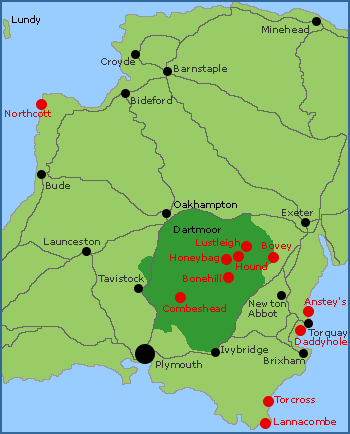Bouldering in Devon and Dartmoor
Devon offers a surprisingly varied and diverse bouldering scene, catering to all levels and styles. Whether you fancy sunning yourself at the coast, exploring adventurous terrain, escaping to the solitude of Dartmoor, or discovering limestone and shale oddities, the bouldering in Devon caters for all tastes. Not only this, but the quality of the bouldering and range of difficulty mean that everyone should be able to find something to climb. Throw in pasties, cream teas, country pubs and a relatively moderate climate, and the result is that Devon is one of the best places in England to go bouldering.
Map of the main bouldering areas in Devon

Bouldering in Dartmoor
The heart of Devon's bouldering soul lies in Dartmoor National Park, with its moorland tors and sheltered woodlands in stunning locations. The granite rock is sharp, with many of the problems having sharp edges and crystals. The friction tends to be good for your feet, but you may sacrifice some skin from your fingers. There are well over 1,600 boulder problems across Dartmoor, covering a wide range of grades and styles. Some of the more popular crags are:
Bonehill Rocks – The most popular bouldering area on Dartmoor. Roadside and with a vast array of problems.
Honeybag Tor – A really good spread of low-to-mid grade problems. A good option in the summer due to a range of north facing problems.
Bovey Woods - Bouldering area in the woods with an extensive collection of mainly mid-to-high grade problems.
Combeshead Tor – An extensive area with lots of easy-to-mid grade problems spread around.
Hound Tor – Justifiably a locals’ favourite and one of the best venues on Dartmoor.
Lustleigh – A sublime area containing several varied sectors and numerous excellent problems. Fairly quick to dry.
All the bouldering on Dartmoor is covered in the Devon bouldering guidebook published by Rockfax. The Dartmoor rock climbing and bouldering guidebook published by the Climbers Club, also covers a huge amount of bouldering on Dartmoor.
Bouldering on the north coast of Devon
Situated just over a mile from Bude, Northcote is one of the most interesting and diverse bouldering areas on the Culm coast, offering enjoyable and friendly climbing throughout the grade range. The style of the bouldering is varied with steep walls, slabs and roofs offering superb technical climbing. The landings are predominantly flat and good (however these can vary hugely with the sand levels), though some exposed boulders require judgement in terms of pads and spotters.
Most of the bouldering is tidal and is accessible for around four hours either side of low tide. Although the beach is west facing, the climbing on the boulders face all directions that gives the advantage of sun or shade when needed. The best time to boulder at Northcote is throughout the spring and summer months when the sea is calm and there are plenty of lazy sunny days.
The sandstone boulders at Lynmouth provide some of Devon’s most adventurous bouldering with esoteric climbing amidst dramatic landscapes. There are good range of problems at all angles, though low friction, wave polished, slopers are abound.
Bouldering on the South Coast of Devon
The bouldering on the south coast of Devon is not as extensive as the other parts of Devon. However, these areas can be perfect for a few hours escape on a non-climbing holiday.
At Start Point area there is Lannacombe Beach and Torcross Boulders. Lannacombe Beach is an esoteric, interesting, and impressive venue offering steep, burly climbing in the upper grades. Whilst Torcross Boulders is a delightful spot with good quality bouldering on the finest wave-washed slate. There are around 40 problems ranging from Fb4 to Fb7c+, including some classics.
Hidden within the tourist hot spots of the Torquay/Torbay area are a handful of fine and varied limestone bouldering venues with convenient and pleasant outlooks. Shoalstone, Daddyhole Beach, Hope’s Nose Beach and some of Anstey’s Cove are true coastal venues with tidal considerations. However, Hope Nose crag and much of Anstey’s Cove are set high above the beach and are non-tidal.
The comprehensive guidebook is called Devon Bouldering by Rockfax. It details over 2,300 boulder problems across a wide range of grades, across 48 crags, with the bulk of the guidebook covering the various areas of Dartmoor.
The Dartmoor Rock Climbing and Bouldering Guidebook covers the bouldering on Dartmoor as well as all the trad climbing.